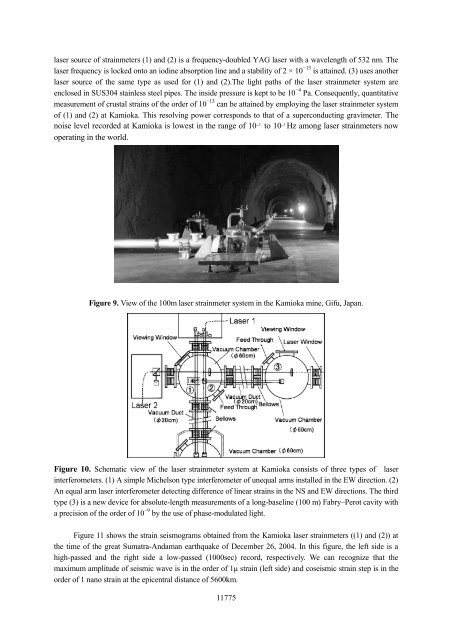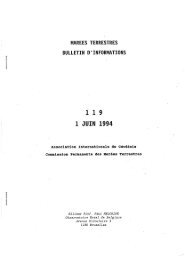marees terrestres bulletin d'informations - Université de la Polynésie ...
marees terrestres bulletin d'informations - Université de la Polynésie ...
marees terrestres bulletin d'informations - Université de la Polynésie ...
Create successful ePaper yourself
Turn your PDF publications into a flip-book with our unique Google optimized e-Paper software.
<strong>la</strong>ser source of strainmeters (1) and (2) is a frequency-doubled YAG <strong>la</strong>ser with a wavelength of 532 nm. The<br />
<strong>la</strong>ser frequency is locked onto an iodine absorption line and a stability of 2 × 10 −13 is attained. (3) uses another<br />
<strong>la</strong>ser source of the same type as used for (1) and (2).The light paths of the <strong>la</strong>ser strainmeter system are<br />
enclosed in SUS304 stainless steel pipes. The insi<strong>de</strong> pressure is kept to be 10 −4 Pa. Consequently, quantitative<br />
measurement of crustal strains of the or<strong>de</strong>r of 10 −13 can be attained by employing the <strong>la</strong>ser strainmeter system<br />
of (1) and (2) at Kamioka. This resolving power corresponds to that of a superconducting gravimeter. The<br />
noise level recor<strong>de</strong>d at Kamioka is lowest in the range of 10 −3 to 10 −1 Hz among <strong>la</strong>ser strainmeters now<br />
operating in the world.<br />
Figure 9. View of the 100m <strong>la</strong>ser strainmeter system in the Kamioka mine, Gifu, Japan.<br />
Figure 10. Schematic view of the <strong>la</strong>ser strainmeter system at Kamioka consists of three types of <strong>la</strong>ser<br />
interferometers. (1) A simple Michelson type interferometer of unequal arms installed in the EW direction. (2)<br />
An equal arm <strong>la</strong>ser interferometer <strong>de</strong>tecting difference of linear strains in the NS and EW directions. The third<br />
type (3) is a new <strong>de</strong>vice for absolute-length measurements of a long-baseline (100 m) Fabry–Perot cavity with<br />
a precision of the or<strong>de</strong>r of 10 −9 by the use of phase-modu<strong>la</strong>ted light.<br />
Figure 11 shows the strain seismograms obtained from the Kamioka <strong>la</strong>ser strainmeters ((1) and (2)) at<br />
the time of the great Sumatra-Andaman earthquake of December 26, 2004. In this figure, the left si<strong>de</strong> is a<br />
high-passed and the right si<strong>de</strong> a low-passed (1000sec) record, respectively. We can recognize that the<br />
maximum amplitu<strong>de</strong> of seismic wave is in the or<strong>de</strong>r of 1μ strain (left si<strong>de</strong>) and coseismic strain step is in the<br />
or<strong>de</strong>r of 1 nano strain at the epicentral distance of 5600km.<br />
11775



